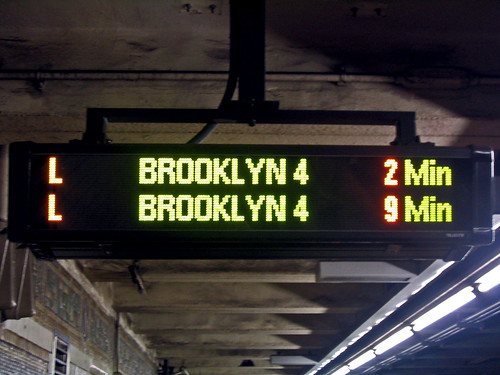
Bus shelters in London know when the next bus is coming. New Yorkers have to result to the tried and true peer-down-the-street method. (Image courtesy of the Department of Transportation)
Public transportation-minded New Yorkers have long bemoaned the state of the MTA’s technology. The Website, as I noted on Friday, has never been too reliable, and other systems around the globe have figured out how to tell riders how far away the next train or bus is. And don’t even get me started on the MTA’s mobile alert system or lack thereof.
But with Wednesday’s crippling flood, everyone else is starting to take notice. On Friday, The New York Times ran an article about the poor state of communications technology in the subways and how riders were left stranded with little information as events unfolded last week.
Citing rapid-response alerts in the Washington Metro, mobile alerts from New Jersey Transit and a mobile trip planning site in San Francisco, Ken Belson and Sewell Chan spoke less glowingly of the Metropolitan Transportation Authority:
In New York — home to the country’s largest transit system, with an $8 billion annual budget — information is doled out in a more elementary fashion. During Wednesday’s crippling storm, when the Metropolitan Transportation Authority’s Web site was overwhelmed by people seeking the latest information and directions, legions of commuters had to rely on station agents scrawling updates on white boards. Only a handful of riders already on train platforms had access to digital screens with up-to-date information…
Compared with commuters in many of the world’s leading cities, subway riders in New York live in something of an information vacuum once they enter the system’s 468 stations…But the storm this week, highlighting yet again deficiencies in how the authority gets information out, seemed to push riders past the limits of their patience. Those flaws are one focus of a 30-day review that Gov. Eliot Spitzer has ordered into what went wrong after the intense early-morning rains of Wednesday.
In the age of cheap bandwidth and pervasive cell phone use, the MTA, the article details, still relies upon telephone calls to every single station agent in the system. These agents are then supposed to be able to recall all of the service information in case passengers need help. Little wonder, then, that system breakdowns are so complete and total when they occur.
But now, the city and state leaders want this ludditism to become a relic of the past. City Councilman John Liu and U.S. Representative Anthony Weiner have renewed their calls for a wired subway system. A cell phone-compatible subway system would allow for text message and voice mail alerts during emergencies.
But outside of a wireless system, the MTA should be able to equip every station and bus stop with the same information readily available elsewhere. It’s not hard to tie the signal system in to a computer that displays the next train’s arrival time. It’s not that hard to equip buses with GPS monitors that show passengers waiting at busy stations when the next bus is due to arrive. It happens in London and Washington, in Madrid and Rome. It’s time to make this happen in New York.
Everyday, at West 4th St., I pass one of the MTA’s digital displays that is, without fail, an hour and 15 minutes slow. If the MTA can’t even get their digital displays to show the time correctly, if they can’t even secure accurate bus route maps at every bus stop, it’s almost naïve of us to think they can handle a full technological upgrade of the subway system. But as the system ages, we need better technology, not more excuses.

 As we await news of the fare hike, let’s instead check in with some technology problems plaguing New York City Transit. Both concern flooding in the system; one’s about the water and the other, people.
As we await news of the fare hike, let’s instead check in with some technology problems plaguing New York City Transit. Both concern flooding in the system; one’s about the water and the other, people.

